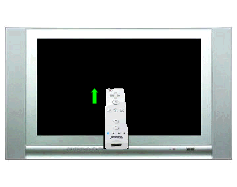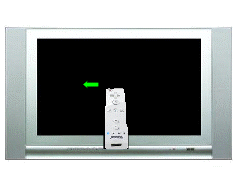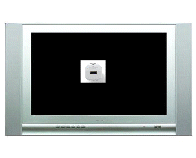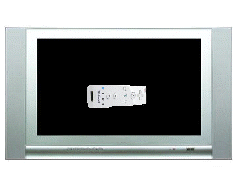The Eight sensorable movements of the revolution controller!!!
The other day I was thinking of how superior the revolution controller is to the analogue stick and I discovered that it will have 8 plains of movement compared to the analogue sticks 2 (forward/backward and left/right) and the mouse's 3 (forward/backward, left/right and the mouse wheel if you have one) so here is a list of all eight, with animations and possible implementation into games.
Pointing Up/Down
Is sensed by TV mounted sensors.
 This works like a mouse, and will proberly be implemented into all menu's of games. Possibilities;
This works like a mouse, and will proberly be implemented into all menu's of games. Possibilities;- FPS aim
- RTS unit select
- Target selecting
Pointing Left/Right
Is sensed by TV mounted sensors.

This works like a mouse, and will proberly be implemented into all menu's of games. Possibilities;
- FPS aim
- RTS unit select
- Target selecting
Depth perception
Is sensed by TV mounted sensors
 This works like a scroll wheel/ the forwards and backwards motion on a analogue stick.
This works like a scroll wheel/ the forwards and backwards motion on a analogue stick.Possibilities;
- walking forward and backwards
- zooming in and out
- speeding up and slowing down (racing/flying)
Left to right
sensed by TV mounted sensors

this works like left and right on the analogue stick.
possibilities;
- strafing
- sword fighting
sensed by TV mounted sensors

this is pretty unique.
possibilities;
- exercise game
- flying
- entering morphball in metroid
turning
is sensed by controllers gyroscopes
 this sort of imitates a steering wheel or if held vertically a joystick.
this sort of imitates a steering wheel or if held vertically a joystick.possibilities;
- racing
- flying
is sensed by controllers gyroscope
 when vertical works like a joystick
when vertical works like a joystickpossibilities;rolling
is sensed by the controllers gyroscopes
 this is pretty unique
this is pretty uniquepossibilities
- roll in flying
- motor bike game
- cool gun effects
all I have done in this article is show the individual movements and how they could be used, it gets interesting when you start combining movements, as this makes the possibilities endless. Where as with an analogue stick the most adventurous thing you can do is walk diagonally with this controller you can have a full sword fight, fly a plane or snipe someone realistically and that isn't even using the nunchuka attachment which adds of course two more movement types.
I did not write this article to say the analogue stick is crap (except perhaps the PSPs nubin) I am just trying to show the world that the revolution controller is better!!!








1 Comments:
I've been wondering about the technology that must be implemented in the controller, and come to the conclusion that in all likelyhood, the TV mounted sensors aren't sensors at all, but transmitters, sending what I believe are most likely infrared pulses. The black plastic window on the front of the control is therefore covering a reciever like most IR sensors. However, there is a key difference to standard IR recievers. Rather than a standard zero dimensional amplitude sensor it likely has a low resolution 2d array: basically an infra red camera that senses the relative positions (and perhaps intensities) of the tv transmitters. This may sound expensive, but it's near identical to the concepts used in optical mice, and as we know, they are dirt cheap.
As for the gyros, I expect it contains 3, one for each direction of rotation. The transmitors are essential for establishing a reference point and any translational movements (vertical, horizontal, in + out) while the gyros sense rotations (roll, pitch and yaw).
The gyros will work in any direction so long as the system's been presented a reference point at some point since the console is turned on. Thier accuracy will reduce over prolonged movement the longer the control isn't referenced (so the control can sense rotation even when not pointing at the screen, but has to be pointed at it periodically to remain accurate). They may be able to sense the plane of gravity, so this might not be much of a problem. The control will not however be able to sense position wihtout being pointed at the screen.
Interestingly, the 2 control mechanisms can essentially combine their measurements when pointing around the screen like a laser pointer to significantly raise their accuracy.
Post a Comment
<< Home